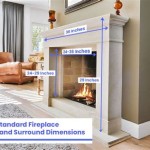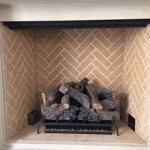Victorian Fireplace Covers: Aesthetics, Function, and Preservation
Victorian fireplace covers, also known as fire screens or fenders, represent a significant facet of Victorian domestic life, serving not only as decorative elements but also as functional tools to manage the open hearth. These covers provide a glimpse into the period's design sensibilities, technological advancements, and social customs surrounding the home and its central gathering point – the fireplace.
The Victorian era, spanning from 1837 to 1901, witnessed a surge in industrial production, making decorative items more accessible to a wider range of households. Fireplace covers benefited from this increased accessibility, evolving from simple utilitarian objects to elaborate displays of craftsmanship and artistry. Understanding their purpose, materials, and design variations offers a compelling insight into Victorian society.
Material and Construction of Victorian Fireplace Covers
The materials used in the construction of Victorian fireplace covers varied widely, reflecting both the wealth of the homeowner and the prevailing aesthetic trends. Cast iron was a common and relatively affordable option, often ornamented with intricate patterns and designs. Brass and copper, known for their durability and aesthetic appeal, were also frequently employed, particularly for more elaborate and expensive covers. Wrought iron, skillfully shaped and decorated, offered a robust and visually striking alternative.
Beyond the metal frame, many fireplace covers incorporated other materials to enhance their functionality or decorative value. Silk or embroidered screens, stretched across a wooden or metal frame, provided a barrier against drafts and embers while adding a touch of elegance to the room. Glass panels, sometimes stained or etched, offered a similar combination of practicality and beauty. Leather, often tooled and embellished, was another material used to add a touch of luxury and sophistication.
The construction techniques employed in creating these covers were often sophisticated, reflecting the skills of the artisans involved. Casting, forging, and soldering were all used to create the metal frames, while woodworking and upholstery skills were essential for incorporating fabrics and other materials. The level of detail and craftsmanship varied considerably, ranging from mass-produced, functional covers to bespoke pieces created by master craftsmen.
Functionality and Purpose in the Victorian Home
Victorian fireplace covers served several crucial functions within the home. Primarily, they acted as a safety measure, preventing sparks and embers from escaping the fireplace and potentially causing fires. Open hearths, while providing warmth and atmosphere, posed a fire hazard, particularly in homes with wooden floors and flammable furnishings.
Fireplace covers also helped to regulate airflow and prevent drafts. The open fireplace, even when not in use, could create a significant draft, making the room uncomfortable. A well-placed fire screen could mitigate this problem, creating a more comfortable and energy-efficient environment. Some covers were designed with adjustable vents or flaps, allowing homeowners to further control the airflow.
Beyond safety and comfort, fireplace covers played a role in preserving the interior décor. They protected delicate furnishings from the heat and soot produced by the fire. Upholstery, carpets, and artwork could all be damaged by prolonged exposure to heat and smoke, and a fire screen provided a crucial barrier.
Design Variations and Aesthetic Trends
The design of Victorian fireplace covers reflected the diverse aesthetic trends of the era. Early Victorian covers often featured Gothic Revival motifs, such as pointed arches, trefoils, and quatrefoils. These designs were inspired by medieval architecture and emphasized a sense of grandeur and historical authenticity. As the Victorian era progressed, other styles, such as Rococo Revival and Aesthetic Movement, gained popularity, influencing the design of fireplace covers.
Rococo Revival covers often featured asymmetrical designs, elaborate scrollwork, and naturalistic motifs like flowers and leaves. These covers were intended to be visually striking and opulent, reflecting the Victorian fascination with ornamentation and display. The Aesthetic Movement, in contrast, emphasized simplicity and elegance, favoring clean lines, geometric patterns, and natural materials. Fireplace covers in this style often featured Japanese-inspired designs or incorporated elements of nature, such as birds and plants.
Furthermore, the size and shape of fireplace covers varied depending on the size and style of the fireplace itself. Smaller covers were commonly used in bedrooms or smaller living rooms, while larger, more elaborate covers were reserved for grander spaces. Some covers were designed to sit directly in front of the fireplace opening, while others were designed to be placed on the hearth or floor. Fenders, low metal barriers placed around the hearth, were also common, offering an additional layer of protection and decoration.
The stylistic choices made in regards of the Victorian fireplace cover became a clear indicator for the social standing and the fashion interests of the families they represented.

Rare And Magnificent Cast Iron Circa 1900 Fireplace Surround Summer Cover With Stylized Griffin Vintage Victorian Tiles

Period And Victorian Fireplace Inserts Bonfire Fireplaces

Fireplace Screens Victorian

Victorian Fire Surrounds Arched Insert Slate

Victorian Cast Iron Fire Surround And Tiled Insert

Victorian Cast Iron Surround The Beaconsfield

Fireplace Covers Victorian

Victorian Trim Sa1969 Blog Fireplace Mantels Antique

Victorian Fireplaces Chesneys

Normandy Cast Iron Tiled Insert 40 Victorian Fireplace
Related Posts








